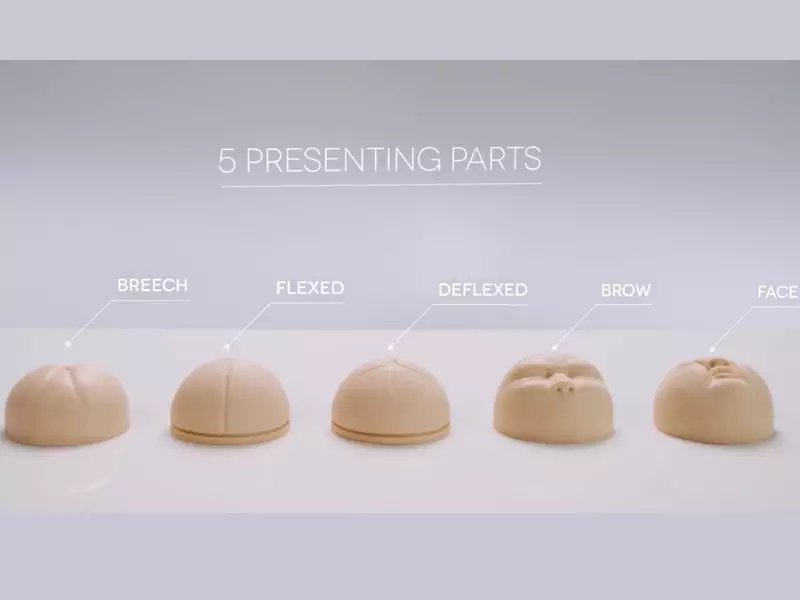When a woman approaches the end of her pregnancy, two key terms start to become more relevant in her journey toward labor and delivery: dilation and effacement. These are indicators of the body preparing for the birth process, marking significant milestones in the progression toward meeting one’s baby for the first time. Understanding the difference between these two terms is crucial for expecting mothers and their families as they navigate the final stages of pregnancy.
Dilation refers to the opening of the cervix measured in centimeters, while effacement describes the thinning and shortening of the cervix, expressed as a percentage. Both processes are essential for the passage of the baby through the birth canal. Dilation from 0 to 10 centimeters and effacement from 0% to 100% are indicators of labor progression, with complete effacement and full dilation being necessary for vaginal delivery.
During the final weeks of pregnancy, healthcare providers monitor these changes closely to assess labor readiness. The cervix must undergo significant transformation, becoming not only dilated but also effaced, to allow for a smooth delivery. This transformation is influenced by various factors, including physical conditions, emotional state, and even prenatal care, highlighting the complexity of childbirth and the incredible adaptability of the human body.

Pregnancy and Labor Basics
Stages of Labor
Labor is a natural process that every pregnant woman goes through as she prepares to give birth. It is divided into three main stages: the first stage, which involves the onset of labor through to full dilation of the cervix; the second stage, which covers the delivery of the baby; and the third stage, which is the delivery of the placenta.
Role of the Cervix in Labor
The cervix plays a pivotal role during labor. It is the lower part of the uterus that opens into the vagina. During pregnancy, the cervix remains closed and firm, protecting the baby inside the womb. As labor approaches, the cervix undergoes significant changes — it softens, shortens, and dilates (opens) to allow the baby to pass through the birth canal. Monitoring the cervix’s changes helps healthcare providers assess labor’s progress.
What is Dilation?
Definition and Significance
Dilation refers to the opening of the cervix measured in centimeters. It is crucial for childbirth, as the cervix must dilate to approximately 10 centimeters for a vaginal delivery. Dilation is a clear indicator that labor has begun or is imminent.
How is Dilation Measured?
Dilation is measured during a pelvic exam. Healthcare providers use their fingers to estimate the cervix’s opening in centimeters. This measurement helps in determining how far labor has progressed.
Factors Affecting Dilation
Several factors can influence the rate and extent of cervical dilation, including:
- Physical activity
- Hydration
- Stress levels
- The position of the baby
What is Effacement?
Definition and Significance
Effacement is the process by which the cervix thins out and shortens in preparation for childbirth. It is measured in percentages, from 0% (no effacement) to 100% (fully effaced). Effacement is essential for dilation to occur effectively.
Measuring Effacement
Effacement is assessed during a pelvic exam, similar to dilation. The healthcare provider evaluates the thickness of the cervix to determine the percentage of effacement.
Factors Influencing Effacement
The progress of effacement can be affected by:
- Maternal age
- Number of previous pregnancies
- Physical activity
- Emotional well-being
Dilation vs. Effacement
Key Differences
While both dilation and effacement are critical for childbirth, they refer to different aspects of cervical change. Dilation measures the opening of the cervix, while effacement refers to the thinning of the cervix.
How They Work Together in Labor
Dilation and effacement often occur simultaneously as the body prepares for childbirth. Effacement generally precedes or accompanies early dilation, making it easier for the cervix to open fully when the time comes.
Monitoring Progress
Methods Used by Healthcare Providers
Healthcare providers use several methods to monitor the progress of labor, including:
- Regular pelvic exams to measure dilation and effacement.
- Observing contractions through manual palpation or electronic monitoring.
- Assessing the baby’s position and descent into the pelvis.
Importance of Monitoring for Labor Readiness
Monitoring dilation and effacement is vital for determining labor readiness and making timely decisions regarding labor and delivery management. It helps in assessing whether labor is progressing normally or if interventions are necessary.

Factors Affecting Dilation and Effacement
The journey to childbirth involves intricate changes within the body, particularly in terms of cervical dilation and effacement. Understanding the factors that influence these changes can provide valuable insights for expecting mothers. These factors range from physical conditions to emotional and psychological states, each playing a distinct role in the labor process.
Physical Factors
Anatomy and Physiology
The physical structure of a woman’s pelvis, including the cervix’s position and the baby’s size, significantly impacts the progression of dilation and effacement. Some women may naturally have a wider pelvis, allowing for easier passage of the baby, while others may face challenges due to a narrower structure.
Maternal Health
A woman’s overall health and wellness also play crucial roles. Conditions such as pre-existing medical issues or gestational diabetes can affect how the body prepares for labor. Moreover, the nutritional status of the mother provides the necessary energy for the uterus to contract effectively.
Previous Pregnancies
Women who have had children before tend to experience quicker processes of dilation and effacement. The cervix and pelvic muscles have previously stretched, potentially leading to an easier labor in subsequent pregnancies.
Emotional and Psychological Factors
Stress Levels
High levels of stress can interfere with the body’s natural labor progression. Stress hormones can inhibit uterine contractions, slowing down dilation and effacement. It’s essential for expecting mothers to find relaxation techniques that work for them to maintain a calm state of mind.
Mental Preparedness
The emotional readiness of a woman to give birth plays a non-negligible role. Those who feel anxious or fearful about childbirth may inadvertently slow the labor process. Conversely, feeling prepared and positive can have a beneficial impact on labor progression.
Preparing for Dilation and Effacement
Preparation for labor involves both physical and mental readiness. Engaging in specific exercises and ensuring comprehensive prenatal care can significantly affect the ease of labor.
Physical Exercises and Techniques
Pelvic Floor Exercises
Strengthening the pelvic floor muscles through exercises like Kegels can enhance control over these muscles during labor, potentially easing the process of dilation and effacement.
Prenatal Yoga
Yoga is renowned for its ability to reduce stress and increase flexibility. Specific poses can help to align the pelvis and encourage the baby to move into the optimal position for birth.
Walking
Regular walking keeps the body active and can help position the baby lower in the pelvis, encouraging cervical changes.
Importance of Prenatal Care
Regular check-ups with healthcare providers are essential. These appointments allow for monitoring the baby’s health, assessing the mother’s condition, and discussing any concerns about labor and delivery. Prenatal care is crucial for identifying any potential issues that could affect labor early on.
Common Questions
When does dilation and effacement begin?
Dilation and effacement can start several weeks before the actual onset of labor. In first-time pregnancies, effacement tends to happen before dilation. For women who have given birth previously, these two processes might occur simultaneously closer to labor.
Can you be dilated without being effaced?
Yes, it’s possible to experience dilation without full effacement. Some women may find themselves a few centimeters dilated weeks before labor begins without significant thinning of the cervix. Every pregnancy is unique, and the order and pace of these changes can vary widely.
How to speed up dilation and effacement?
While the natural progression of labor cannot be forced, there are methods to encourage dilation and effacement:
- Staying active: Gentle activities like walking can help.
- Pelvic tilts: These exercises can align the pelvis and baby optimally.
- Relaxation techniques: Reducing stress through meditation or breathing exercises may facilitate labor progression.
- Consulting a healthcare provider: They may recommend other safe practices or interventions if necessary.
Frequently Asked Questions
When does dilation and effacement begin?
Dilation and effacement can start weeks before actual labor begins. Some women may experience early dilation or effacement as their body gradually prepares for birth. However, significant progress typically occurs closer to actual labor, which is why regular check-ups are crucial in the final weeks of pregnancy to monitor these changes.
Can you be dilated without being effaced?
Yes, it’s possible to be dilated without significant effacement. Dilation and effacement can occur independently or simultaneously. Some women may notice their cervix opening (dilating) before it thins (effaces), while for others, effacement may precede dilation. Both processes are vital for labor, but they don’t always progress at the same rate.
How to speed up dilation and effacement?
While there’s no guaranteed way to speed up dilation and effacement, certain methods may encourage progress. Staying active, engaging in specific exercises like walking or prenatal yoga, and utilizing techniques such as birthing balls can help. Always consult with a healthcare provider before attempting any method to induce or accelerate labor.
Conclusion
The journey towards childbirth is a profound experience, marked by the body’s remarkable ability to prepare for the monumental task of bringing new life into the world. Understanding the difference between dilation and effacement is not just about acquiring knowledge; it’s about embracing the intricate dance of birth. It highlights the body’s preparation for one of its most natural, yet awe-inspiring processes.
As expecting mothers and their families await the arrival of their newest member, recognizing the signs of labor progression offers reassurance and a sense of readiness. The journey through pregnancy to delivery is a testament to the strength and resilience of the human body. With each change, each centimeter dilated, and each percentage effaced, we move closer to the moment that changes lives forever—the birth of a child.
